语言学流派
语言学流派总结

4-3AD
出现了零星的对语法现象的说明
3AD-3BC
中国语言学开创时期,产生了文字学和训诂学。最早的词典《尔雅》东汉《说文解字》,解释了字记录的原始的语言意义。东汉出现词源学著作《释名》,解释词语产生的原因。
转换生成语言学
20世纪50年代后期在美国形成的语言学流派。代表学者是Chomsky。继承前人的演绎方法指出美国描写语言学的归纳方法的缺陷,强调从人认知心理学的角度对人类语言共性的普遍解释,区分人的大脑先天具备的语言能力和后天获得的语言知识,认为语言又生成能力,是有限规则的无限使用,转换是生成的重要手段。把语言的内容和形式有机地结合起来研究。
古罗马
把亚历山大里亚学派的希腊语法体系照搬到拉丁语上,编写出系统而使用的教材,通过教材传播了亚历山大里亚的语法思想。
4-14世纪欧洲封建社会
拉丁语使唯一被研究的语言,它的语法规则也被套到其他语言上。语言研究方面讲究维护传统规范。由于经院哲学的影响,出现了用逻辑代替语法的思辨语法。为了翻译传播《圣经》,出现了不少词典。
乔母斯基认为语言知识包括两部分,一部分是人类属性,是人类天生共同具备的普遍语言知识,一部分是在人类生存经验中后来获得的个别语言知识。他认为语言学应该采用演绎法,从语言能力研究中揭示人的认知过程。1957年他发表《句法结构》,标志着转换生成语言学的诞生。他提出利用移位、复写、插入、删除等转换规则把有限的核心句子转换成无限的非核心句子。这时的语法分析不考虑语义。
3-14世纪
音韵学占统治地位。
魏晋南北朝时期:开始重视语音结构的分析,编写韵书。
语言学流派

语言学流派语言学是研究语言的科学,它涉及到语言的结构、规则、功能以及语言与思维的关系等方面。
在语言学的研究中,有两个主要的流派,分别是形式主义派和功能派。
这两个流派在语言学的研究方法、理论观点以及研究重点上存在一定的差异。
形式主义派是一种以形式为中心的语言学流派。
形式主义派强调语言的内部结构、规则和形式,关注语言的句法、语音、词汇等方面。
形式主义派的代表人物有索绪尔、布洛赫等。
他们认为语言是一个独立的系统,与人类的思维和社会无关,语言的功能是次要的。
形式主义派通过研究语言的形式规则和结构,揭示语言的内在逻辑和规律。
功能派是一种以功能为中心的语言学流派。
功能派强调语言的使用和交际功能,关注语言的意义、语用、语境等方面。
功能派的代表人物有马尔库斯、哈贝马斯等。
他们认为语言是一种社会交往工具,语言的形式和结构是为了实现语言的功能。
功能派通过研究语言的使用和交际情境,揭示语言的功能和意义。
形式主义派和功能派在语言学的研究方法上存在一定的差异。
形式主义派主要采用分析和归纳的方法,通过对语言的形式和规则进行抽象和概括,寻找语言的普遍规律。
功能派主要采用描述和解释的方法,通过对语言的使用和交际情境进行观察和分析,揭示语言的功能和意义。
形式主义派和功能派在语言学的理论观点上存在一定的差异。
形式主义派认为语言是一种独立的系统,与人类的思维和社会无关,语言的功能是次要的。
功能派认为语言是一种社会交往工具,与人类的思维和社会密切相关,语言的形式和结构是为了实现语言的功能。
形式主义派和功能派在语言学的研究重点上存在一定的差异。
形式主义派主要关注语言的内部结构、规则和形式,研究语言的句法、语音、词汇等方面。
功能派主要关注语言的使用和交际功能,研究语言的意义、语用、语境等方面。
形式主义派和功能派是两个主要的语言学流派。
形式主义派强调语言的形式和结构,关注语言的内部规律;功能派强调语言的使用和交际功能,关注语言的意义和功能。
语言学流派

文艺复兴运动在欧洲,但这一时期是欧洲人学习、翻译“外语”(阿拉伯文、拉丁文、希腊文)的时期,换言之,文艺复兴运动的文化和理论基础是从希腊语和拉丁语那里借来的。
印欧语系是世界上最大的语系,它包括两种伟大的古典语言:古希腊语和拉丁语。
因此,可以说,没有希腊语和拉丁语,就没有欧洲文艺复兴运动的萌芽。
拉丁语(Latina Lingua)与希腊语同为影响欧美学术与宗教最深的语言,属于印欧语系意大利语族。
是一种已灭亡的语言,在9世纪,通俗拉丁语发展为多种罗曼语言。
拉丁语原本是意大利中部拉提姆地方(Latium,意大利语为Lazio)的方言,后来则因为发源于此地的罗马帝国势力扩张而将拉丁语广泛流传于帝国境内,并定拉丁文为官方语言。
而基督教普遍流传于欧洲后,拉丁语更加深其影响力,从欧洲中世纪至20世纪初叶的罗马天主教为公用语,学术上论文也大多数由拉丁语写成。
现在虽然只有梵蒂冈尚在使用拉丁语,但是一些学术的词汇或文章例如生物分类法的命名规则等尚使用拉丁语。
罗马帝国的奥古斯都皇帝时期使用的文言文称为“古典拉丁语”(Classic Latin),而2-6世纪民众所使用的白话文则称为“通俗拉丁语”(Vulgar Latin)。
而通俗拉丁文在中世纪又衍生出一些“罗曼语族”(Romance),包括中部罗曼语:法语(French)、意大利语(Italian)、萨丁岛(Sardinia)方言、加泰罗尼亚(Catalonia);西部罗曼语:西班牙语(Spanish)、葡萄牙语(Portugese);与东部罗曼语:罗马尼亚语(Romanian)。
十六世纪后西班牙与葡萄牙势力扩张到整个中南美洲,因此中南美洲又称“拉丁美洲”(Latin America)。
罗曼语和拉丁语的区别在于,罗曼语都失去了很多单词的语法变化词尾、特别是名词的变格词尾,已经完全丧失(一些代词除外)。
(名词变格在罗马尼亚语中仍然有所保留)。
德国雅各·格林(Jakob Grimm)提出,属于印欧语的语言不仅有共同的词汇和共同的形态,语音的变化很有规律。
第一讲 语言学的分类和流派

特点: (1)语法形式化。采用数理逻辑的形式化方
法,根据有限的公理化规则系统演绎生成无 限的句子。力图做到像数学公式般形式化。 (2)解释性。该语法的目的不在于分类,归 纳,而在于解释生成语言的机制。 (3)演绎性。由于多采用形式化推理,所以 该理论演绎性多于归纳性。
言语,强调研究语言的语言学、内部语言学。
第十七页,编辑于星期一:十七点 十九分。
(4)描写性。从言语、话语入手,着重发 现与描写共时语言系统的各类结构。
(5)归纳的方法多于演绎的方法。 (6)客观性。由于要细致归纳描写当代语
言,因此较少主观臆断,比较客观。 (7)重视语言表面结构,缺乏深层结构的
了解。 (8)重视静态的语言结构,忽视动态的言
第二十七页,编辑于星期一:十七点 十九分。
5.从研究范围看,语言学可大体分为两大类: ( )语言学和( )语言学。根据研究对象 的时间,语言学可以分为( )语言学和( ) 语言学。(2007,华中师大)
6.结构主义语言学的三个主要分支是: ( )、( )和( )。(2007,华中师大)
7.古代语言学有三个传统:( )传统、( ) 传统和( )传统。(2008,华中师大)
第二十五页,编辑于星期一:十七点 十九分。
4.()被认为是普通语言学的奠基人。 (2006,中国传媒大学) A.乔姆斯基和索绪尔 B.洪堡特和索绪尔 C.布龙菲尔德和洪堡特 D.布龙菲尔德和乔姆 斯基
二、填空题 1.( )被尊为现代语言学之父。(2004,南
开)
第二十六页,编辑于星期一:十七点 十九分。
历史比较语言学是语言学走上独立发展道路的标志是语言学史上一个里程碑历史比较语言学建立了比较的方法考察语言的历史来源和亲属关系为语言建立了谱系对各种语言做出了谱系分类为研究人类语言的共同规律的普通语言学的诞生奠定了坚实的基础
关于语言学的各类流派

语言学流派历史比较语言学历史比较语言学从前又称比较语法,通过语言亲属关系的比较研究语言的发展规律,拟测它们的共同母语。
历史比较语言学是在19世纪逐步发展和完善的,主要是印欧语系的历史比较。
19世纪之前,这种研究不是没有,但都是孤立的分散的研究,到19世纪才进入系统的研究,并使语言学走上独立发展的道路。
历史比较语言学的产生有两个不可或缺的条件,一是广泛收集世界各种语言材料,二是认识到梵语在语言比较中的地位和作用。
19世纪历史比较语言学在理论和方法上的发展大致可以分为三个阶段。
在初始阶段,丹麦的拉斯克(R·Rask)、德国的格里姆(J·Grimm)和葆扑(F·Bopp)被称为历史比较语言学的奠基者。
拉斯克在他的《古代北欧语或冰岛语起源研究》一书中第一个对基本语汇中的词进行系统的比较,找出其中的语音对应规律,由此确定语言的亲缘关系。
格里姆在拉斯克一书的启发下,在他的《日耳曼语语法》里确定了希腊语、峨特语和高地德语之间的语音对应关系,即所谓的“格里姆定律”(Grimm's Law)。
格里姆明确指出,语音对应规律是建立印欧语系和其他语系的基础。
维尔纳(K·Verner)后来补充解释清楚了“格里姆定律”难以解释的一组例外,世称“维尔纳定律”,这就使音变规律的研究日臻完善,历史比较语言学的发展也就有了扎实的理论基础。
葆朴的主要著作是《梵语、禅德语、亚美尼亚语、希腊语、拉丁语、立陶宛语、古斯拉夫语、峨特语和德语比较语法》,旨在把梵语和欧洲、亚洲的几种其他语言相比较,找出它们在形态上的共同来源。
远离欧洲的梵语在这些语言中找到了它应有的位置:它既不是拉丁语、希腊语和其他欧洲语言的母语,也不是由其他语言演变而来,它和其他语言都出于一种共同的原始语言,只不过它比其他语言保存更多的原始形式。
19世纪中期,历史比较语言学发展到第二阶段,最有代表性的人物是德国的施莱歇尔(August Schleicher),其代表作是《印度日耳曼语系语言比较语法纲要》。
语言学流派专题知识

构造主义语言学阶段性小结
1950年代:构造主义旳时代 研究对象:作为人类行为旳语言 研究范式:发觉程序+分布理论(如音位
旳描写) 哲学基础:行为主义 关心旳是对语言本身旳构造和系统旳描写 就语言而研究语言和为语言而研究语言
构造主义语言学旳三个流派
1、布拉格学派
布拉格学派 也称功能语言学派。该学派创建于1926年10月,以布拉格语言学会成立
外部语言和内部语言
两者旳关系体现为:“外部语言学首先引起内部 语言学问题,继而成为内部语言学旳承载,内部 语言学则不失时机地转化为外部语言学旳前提。 内部语言学涉及言语体系旳恒定方面,它超越时 间和空间等诸多原因旳影响,是语言抽象旳部分; 外部语言学则观照语言旳动态方面,受制于时间 或空间,是言语体系旳具象旳部分。”“没有外 部语言学我们便不可能聚焦于内部语言学,便不 可能了解那种抽象旳‘一般’旳存在,而没有内 部语言学,我们便无从感知理论形态与实际中具 象旳言语之间旳关系,便无从实现理论旳升华与 转化。”
他一直在麻省理工学院任教,并任美国科学增进会委员、
美国科学院和文理科学院院士。他在29岁时出版旳《句法 构造》提出了转换生成语法旳思想,从而奠定了他在当代
语言学中旳地位。由他主持开发旳人机对译系统采用了转
换生成语法原理,成功地实现了印欧语系中不同语言之间
ቤተ መጻሕፍቲ ባይዱ
旳人机对译,被广泛用于国际会议旳同声传译。他后来提
构造主义语言学旳三个流派
3、美国描写语言学派
这个学派最主要旳人物是布龙菲尔德,他被誉为“美国语言学家之首”。 他于1933年出版旳《语言论》宣告了美国构造主义学派正式诞生。布龙 菲尔德在《语言论》中制定了语言构造旳基本原则和措施,成为这个学 派旳理论指南,所以有人称该学派为“布龙菲尔德学派”。
结构主义语言学的三个流派

结构主义语言学的三个流派导读:瑞士著名语言学家索绪尔是现代语言学的奠基者,是结构主义的创始人。
索绪尔的思想对整个人文科学产生了深远的影响。
在索绪尔之后,出现了结构主义语言学的三个流派:布拉格学派、哥本哈根学派、美国描写语言学派。
下面对这三个流派的代表人物、代表著作、基本学术观点及其贡献作一个简明的介绍。
布拉格学派也称功能语言学派。
该学派创立于1926年10月,以布拉格语言学会成立为标志,其创始人为马泰休斯,他担任这个学会的首任会长。
马泰休斯是布拉格学派的早期理论家,他深刻地分析了新语法学派的缺陷,强调以共时观指导语言研究。
特鲁别茨柯依是布拉格学派的杰出代表,他的《音位学原理》是现代音位学的经典著作。
另一位成就卓著的代表人物是雅柯布逊,他提出的“区别性特征”的学说对现代语言学具有重大意义。
法国著名语言学家马丁内虽然没有正式参加布拉格语言学会,但由于他的语言观体现了布拉格学派的学术思想,所以有的学者把他作为布拉格学派的代表人物。
布拉格学派自称结构-功能学派,他们的语言观是结构主义和功能主义的结合。
他们提出语言是多功能的结构体系,由多个相互依存的次系统构成;建立了音位学说;提出了“语言联盟”的理论和“句子的实际切分”的学说。
布拉格学派主要以音位研究著称,其主要贡献是首次系统地阐明了音位学的任务、原理和研究方法,使它在结构主义语言学诸领域中居于领先地位。
美国语言学家鲍林格评价说:“欧洲任何其他语言学团体都没有象布拉格语言学会那样产生了如此巨大的影响。
”哥本哈根学派也称丹麦学派,又叫语符学派,创立于1931年,以哥本哈根语言学会成立为标志。
代表人物为叶尔姆斯列夫、布龙达尔、乌尔达尔。
代表著作有叶尔姆斯列夫的《语言理论纲要》、布龙达尔的《结构语言学》、乌尔达尔的《语符学纲要》。
哥本哈根学派的核心人物是叶尔姆斯列夫,他对语言的观察细致入微,注意到了语言的一些重要特质:语言的遗传性、社会性、符号性;语言与思维的关系;语言与文化的关系;语言与言语的区别等。
语言学流派哥本哈根学派

语言学流派哥本哈根学派语言学流派哥本哈根学派语言学,流派,哥本哈根学派这是受到索绪尔(F.De.Saussure)语言学思想影响而出现的世界三个结构主义语言学的主要流派之一。
它以1931年哥本哈根语言学会的成立为标志,主要创始人和理论家是丹麦哥本哈根大学的语言学教授L.叶尔姆斯列夫(Louis Hjelmslev,1899-1965)。
早期的理论家还有H.乌尔达尔(1907-1957)和V.布伦达尔(1887-1942)。
该学派规模很小,成员大多是北欧的一些语言学家,活动地区基本上限于哥本哈根,学派的机关刊物是创刊于1939年的《语言学文献》。
该学派的理论叫做"语符学"。
20世纪30年代初,叶尔姆斯列夫和乌尔达尔研究语音学和音位学的理论,提出了"音声学"理论,接着又把它发展成为一般性理论。
为了强调跟以前的语言学不同,他们把自己的理论定名为"glossematics"(语符学)。
语符学的基本设想由乌尔达尔写成小册子《语符学大纲》,1936年在哥本哈根国际语言学大会上散发,其后因乌尔达尔到希腊工作,学派的理论工作由叶尔姆斯列夫承担。
叶尔姆斯列夫的论著很多,代表作是《语言理论导论》(1943,丹麦文),1953年该书被译成英文出版,语符学才受到人们的注意。
该书从哲学和逻辑学的角度阐述语言学的理论性问题,明确提出语言的符号性质,是哥本哈根学派的理论纲领。
该学派发展了索绪尔的"语言是形式,而不是实质""语言是价值系统"的论断,主张把语言从物理方面的声音和心理方面的语义抽象出来,并且排除语言对社会的依存和语言历史演变因素的制约,以便集中研究语言的内在结构。
叶尔姆斯列夫主张以经验主义原则和演绎法看待语言,一方面认为语言理论要经得起语言事实的检验,另一方面又认为语言事实和语言理论是互补的,可以进行单纯的理论研究。
语言学流派及其发展
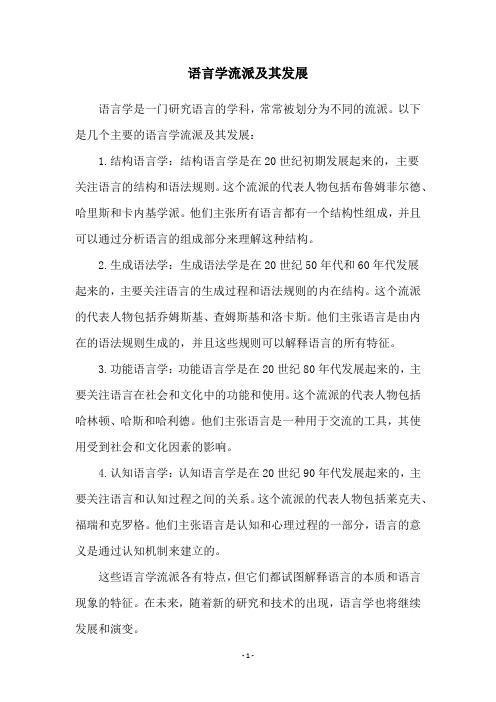
语言学流派及其发展
语言学是一门研究语言的学科,常常被划分为不同的流派。
以下是几个主要的语言学流派及其发展:
1.结构语言学:结构语言学是在20世纪初期发展起来的,主要
关注语言的结构和语法规则。
这个流派的代表人物包括布鲁姆菲尔德、哈里斯和卡内基学派。
他们主张所有语言都有一个结构性组成,并且可以通过分析语言的组成部分来理解这种结构。
2.生成语法学:生成语法学是在20世纪50年代和60年代发展
起来的,主要关注语言的生成过程和语法规则的内在结构。
这个流派的代表人物包括乔姆斯基、查姆斯基和洛卡斯。
他们主张语言是由内在的语法规则生成的,并且这些规则可以解释语言的所有特征。
3.功能语言学:功能语言学是在20世纪80年代发展起来的,主要关注语言在社会和文化中的功能和使用。
这个流派的代表人物包括哈林顿、哈斯和哈利德。
他们主张语言是一种用于交流的工具,其使用受到社会和文化因素的影响。
4.认知语言学:认知语言学是在20世纪90年代发展起来的,主要关注语言和认知过程之间的关系。
这个流派的代表人物包括莱克夫、福瑞和克罗格。
他们主张语言是认知和心理过程的一部分,语言的意义是通过认知机制来建立的。
这些语言学流派各有特点,但它们都试图解释语言的本质和语言现象的特征。
在未来,随着新的研究和技术的出现,语言学也将继续发展和演变。
语言学流派
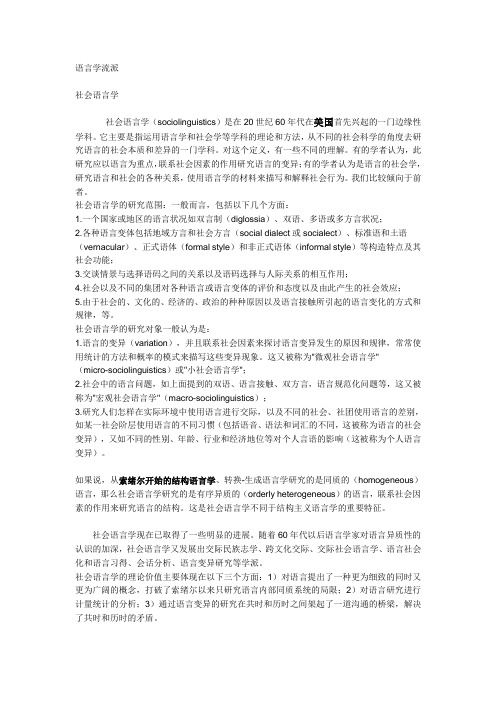
语言学流派社会语言学社会语言学(sociolinguistics)是在20世纪60年代在美国首先兴起的一门边缘性学科。
它主要是指运用语言学和社会学等学科的理论和方法,从不同的社会科学的角度去研究语言的社会本质和差异的一门学科。
对这个定义,有一些不同的理解。
有的学者认为,此研究应以语言为重点,联系社会因素的作用研究语言的变异;有的学者认为是语言的社会学,研究语言和社会的各种关系,使用语言学的材料来描写和解释社会行为。
我们比较倾向于前者。
社会语言学的研究范围:一般而言,包括以下几个方面:1.一个国家或地区的语言状况如双言制(diglossia)、双语、多语或多方言状况;2.各种语言变体包括地域方言和社会方言(social dialect或socialect)、标准语和土语(vernacular)、正式语体(formal style)和非正式语体(informal style)等构造特点及其社会功能;3.交谈情景与选择语码之间的关系以及语码选择与人际关系的相互作用;4.社会以及不同的集团对各种语言或语言变体的评价和态度以及由此产生的社会效应;5.由于社会的、文化的、经济的、政治的种种原因以及语言接触所引起的语言变化的方式和规律,等。
社会语言学的研究对象一般认为是:1.语言的变异(variation),并且联系社会因素来探讨语言变异发生的原因和规律,常常使用统计的方法和概率的模式来描写这些变异现象。
这又被称为"微观社会语言学"(micro-sociolinguistics)或"小社会语言学";2.社会中的语言问题,如上面提到的双语、语言接触、双方言,语言规范化问题等,这又被称为"宏观社会语言学"(macro-sociolinguistics);3.研究人们怎样在实际环境中使用语言进行交际,以及不同的社会、社团使用语言的差别,如某一社会阶层使用语言的不同习惯(包括语音、语法和词汇的不同,这被称为语言的社会变异),又如不同的性别、年龄、行业和经济地位等对个人言语的影响(这被称为个人语言变异)。
语言学流派及其发展
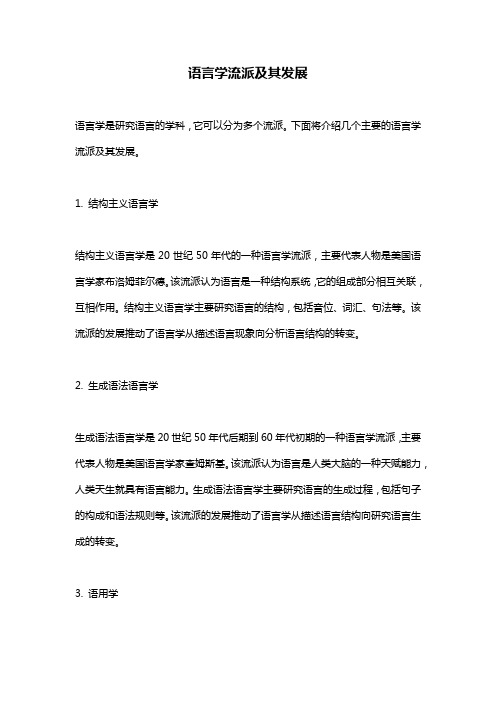
语言学流派及其发展语言学是研究语言的学科,它可以分为多个流派。
下面将介绍几个主要的语言学流派及其发展。
1. 结构主义语言学结构主义语言学是20世纪50年代的一种语言学流派,主要代表人物是美国语言学家布洛姆菲尔德。
该流派认为语言是一种结构系统,它的组成部分相互关联,互相作用。
结构主义语言学主要研究语言的结构,包括音位、词汇、句法等。
该流派的发展推动了语言学从描述语言现象向分析语言结构的转变。
2. 生成语法语言学生成语法语言学是20世纪50年代后期到60年代初期的一种语言学流派,主要代表人物是美国语言学家查姆斯基。
该流派认为语言是人类大脑的一种天赋能力,人类天生就具有语言能力。
生成语法语言学主要研究语言的生成过程,包括句子的构成和语法规则等。
该流派的发展推动了语言学从描述语言结构向研究语言生成的转变。
3. 语用学语用学是20世纪60年代后期到70年代初期的一种语言学流派,主要代表人物是英国语言学家格里斯。
该流派认为语言是一种交际行为,它的目的是传递信息。
语用学主要研究语言的使用,包括语言交际的目的、语言交际的情境、语言交际的效果等。
该流派的发展推动了语言学从研究语言结构向研究语言使用的转变。
4. 社会语言学社会语言学是20世纪60年代后期到70年代初期的一种语言学流派,主要代表人物是美国语言学家拉卡特。
该流派认为语言是一种社会现象,它的使用受到社会因素的影响。
社会语言学主要研究语言的社会方面,包括语言变异、语言变化、语言规范等。
该流派的发展推动了语言学从研究语言结构向研究语言使用和社会因素的转变。
总之,语言学流派的发展推动了语言学从单一的研究语言结构向多方面的研究转变,丰富了语言学的研究内容和方法。
语言学流派(结构主义语言学)

结构主义语言学三大流派瑞士著名语言学家索绪尔是现代语言学的奠基者,是结构主义的创始人。
索绪尔的思想对整个人文科学产生了深远的影响。
在索绪尔之后,出现了结构主义语言学的三个流派:布拉格学派、哥本哈根学派、美国描写语言学派。
以下就这三个流派的代表人物、代表著作、基本学术观点及其贡献分别作一个简要介绍。
一、布拉格学派也称功能语言学派。
该学派创立于1926年10月,以布拉格语言学会成立为标志,其创始人为马泰休斯,他担任这个学会的首任会长。
马泰休斯是布拉格学派的早期理论家,他深刻地分析了新语法学派的缺陷,强调以共时观指导语言研究。
特鲁别茨柯依是布拉格学派的杰出代表,他的《音位学原理》是现代音位学的经典著作。
另一位成就卓著的代表人物是雅柯布逊,他提出的“区别性特征”的学说对现代语言学具有重大意义。
法国著名语言学家马丁内虽然没有正式参加布拉格语言学会,但由于他的语言观体现了布拉格学派的学术思想,所以有的学者把他作为布拉格学派的代表人物。
布拉格学派自称结构-功能学派,他们的语言观是结构主义和功能主义的结合。
他们提出语言是多功能的结构体系,由多个相互依存的次系统构成;建立了音位学说;提出了“语言联盟”的理论和“句子的实际切分”的学说。
布拉格学派主要以音位研究著称,其主要贡献是首次系统地阐明了音位学的任务、原理和研究方法,使它在结构主义语言学诸领域中居于领先地位。
美国语言学家鲍林格评价说:“欧洲任何其他语言学团体都没有象布拉格语言学会那样产生了如此巨大的影响。
”二、哥本哈根学派也称丹麦学派,又叫语符学派,创立于1931年,以哥本哈根语言学会成立为标志。
代表人物为叶尔姆斯列夫、布龙达尔、乌尔达尔。
代表著作有叶尔姆斯列夫的《语言理论纲要》、布龙达尔的《结构语言学》、乌尔达尔的《语符学纲要》。
哥本哈根学派的核心人物是叶尔姆斯列夫,他对语言的观察细致入微,注意到了语言的一些重要特质:语言的遗传性、社会性、符号性;语言与思维的关系;语言与文化的关系;语言与言语的区别等。
语言学各学派
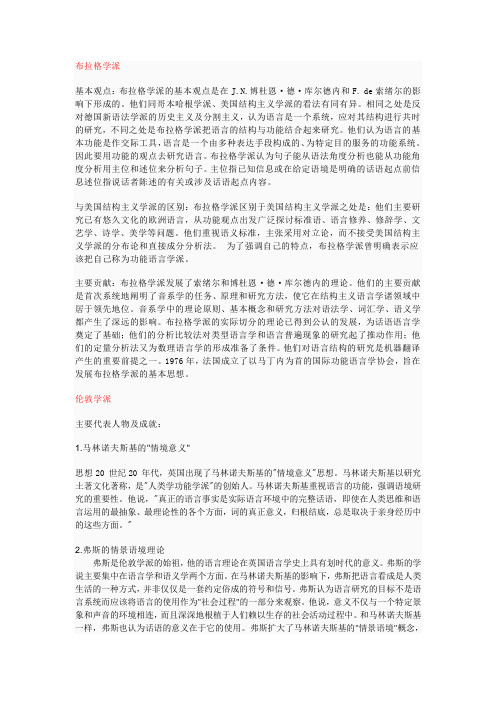
布拉格学派基本观点:布拉格学派的基本观点是在J.N.博杜恩·德·库尔德内和F. de索绪尔的影响下形成的。
他们同哥本哈根学派、美国结构主义学派的看法有同有异。
相同之处是反对德国新语法学派的历史主义及分割主义,认为语言是一个系统,应对其结构进行共时的研究,不同之处是布拉格学派把语言的结构与功能结合起来研究。
他们认为语言的基本功能是作交际工具,语言是一个由多种表达手段构成的、为特定目的服务的功能系统。
因此要用功能的观点去研究语言。
布拉格学派认为句子能从语法角度分析也能从功能角度分析用主位和述位来分析句子。
主位指已知信息或在给定语境是明确的话语起点前信息述位指说话者陈述的有关或涉及话语起点内容。
与美国结构主义学派的区别:布拉格学派区别于美国结构主义学派之处是:他们主要研究已有悠久文化的欧洲语言,从功能观点出发广泛探讨标准语、语言修养、修辞学、文艺学、诗学、美学等问题。
他们重视语义标准,主张采用对立论,而不接受美国结构主义学派的分布论和直接成分分析法。
为了强调自己的特点,布拉格学派曾明确表示应该把自己称为功能语言学派。
主要贡献:布拉格学派发展了索绪尔和博杜恩·德·库尔德内的理论。
他们的主要贡献是首次系统地阐明了音系学的任务、原理和研究方法,使它在结构主义语言学诸领域中居于领先地位。
音系学中的理论原则、基本概念和研究方法对语法学、词汇学、语义学都产生了深远的影响。
布拉格学派的实际切分的理论已得到公认的发展,为话语语言学奠定了基础;他们的分析比较法对类型语言学和语言普遍现象的研究起了推动作用;他们的定量分析法又为数理语言学的形成准备了条件。
他们对语言结构的研究是机器翻译产生的重要前提之一。
1976年,法国成立了以马丁内为首的国际功能语言学协会,旨在发展布拉格学派的基本思想。
伦敦学派主要代表人物及成就:1.马林诺夫斯基的"情境意义"思想20 世纪20 年代,英国出现了马林诺夫斯基的"情境意义"思想。
关于语言学流派的书籍

关于语言学流派的语言学流派:从历史比较语言学到跨文化交际学语言学是一门研究人类语言的学科,其流派众多,各有独特的观点和贡献。
本文将介绍历史比较语言学、结构主义语言学、功能主义语言学、生成语言学、认知语言学、社会语言学、语用学和跨文化交际学等主要语言学流派。
1. 历史比较语言学历史比较语言学是语言学的一个分支,主要研究语言的演变和对比。
该流派的代表人物包括雅各布·格林和拉斯姆茨·格林兄弟等。
他们通过对不同语言的比较研究,揭示了语言之间的亲缘关系,为语言的分类和演化提供了重要证据。
历史比较语言学对于理解语言的起源和发展具有重要意义。
2. 结构主义语言学结构主义语言学是20世纪初兴起的一个语言学流派,强调对语言结构的研究。
索绪尔是该流派的代表人物之一,他提出了“语言”和“言语”的概念,并认为语言是一个符号系统。
结构主义语言学通过对语言结构的分析,揭示了语言的内部规律和特征,为后续的语言学研究提供了重要基础。
3. 功能主义语言学功能主义语言学关注语言在实际交际中的功能和用途。
该流派认为,语言是人类社会交际的工具,语言的演变和变化都受到社会交际的影响。
功能主义语言学的研究重点包括语言的语篇分析、话语分析和语用分析等。
通过对语言的实际使用情况进行研究,该流派为揭示语言与文化、社会背景之间的关系提供了有益的见解。
4. 生成语言学生成语言学主要研究语言的生成机制和语法规则。
该流派认为,人类具有天生的语言能力,能够生成无限的、符合语法规则的语句。
生成语言学的研究重点包括语言的语法分析、句法分析和语义分析等。
生成语言学对于揭示语言的本质和人类的语言能力具有重要意义。
5. 认知语言学认知语言学主要研究语言的认知过程和人类的思维方式。
该流派认为,语言是人类认知的一部分,语言的形成和发展受到人类认知的影响。
认知语言学的研究重点包括语言的隐喻、意象和范畴等。
通过对语言的认知过程进行深入研究,该流派揭示了人类思维与语言之间的关系,为深入理解人类认知提供了有益的见解。
专业的语言学史与语言学派

专业的语言学史与语言学派语言学是研究人类语言的科学,它以探究语言的起源、发展和演变为主要目标。
在这个学科中,我们可以看到一些重要的历史和学派对语言学的发展产生了深远的影响。
本文将介绍一些专业的语言学史和语言学派,以帮助读者更好地了解这个学科。
一、结构主义语言学结构主义语言学是20世纪中期兴起的一种语言学派别,它强调语言结构的重要性。
代表人物有弗迦(Ferdinand de Saussure)和布洛伊斯(Leonard Bloomfield),他们对语言的各个层面进行了深入研究。
结构主义语言学提出了一些重要的概念,如语言单位的差异性、语言符号的意义、语言系统的结构等。
这些概念在后来的语言学研究中起到了重要的作用。
二、生成语法学派生成语法学派是20世纪60年代以来兴起的一种语言学派别,它强调语言的生成和解释过程。
诺姆·乔姆斯基(Noam Chomsky)是这个学派的代表人物,他提出了生成语法理论。
生成语法认为,语言的结构是由一系列产生式规则生成的。
这种理论不仅解决了传统语法对语言结构的局限,还揭示了语言生成和理解的机制。
三、功能语言学派功能语言学派是20世纪70年代以来兴起的一种语言学派别,它关注语言的使用和交际功能。
哈斯肯斯(Michael A.K. Halliday)是这个学派的代表人物,他提出了功能语言学理论。
功能语言学认为,语言是一种社会工具,它不仅仅用于表达意义,还承担着社会和文化功能。
这种理论为语言学研究提供了新的视角和方法。
四、认知语言学派认知语言学派是20世纪80年代以来兴起的一种语言学派别,它强调语言与思维之间的关系。
拉卡托斯(George Lakoff)和约翰逊(Mark Johnson)是这个学派的代表人物,他们提出了认知语言学理论。
认知语言学认为,语言是思维的表达形式,它反映了人类对世界的认知方式。
这种理论帮助我们理解语言与思维之间的密切联系。
五、社会语言学派社会语言学派是20世纪60年代以来兴起的一种语言学派别,它研究语言与社会之间的关系。
各语言学流派的简单对比

各语言学流派的简单对比现代语言学的基本分类总览索绪尔-现代语言学开端结构主义语言学转换-生成语言学伦敦语言学哥本哈根学派(又称丹麦学派)布拉格学派美国的结构主义(美国描绘主义学派)在索绪尔《普通语言学》的基础上演变为索绪尔-现代语言学的开端•瑞士语言学家索绪尔的《普通语言学教程》是一部跨时代的著作,提出了一整套新的理论与方法,奠定了结构主义语言学的基础。
• 1.区分语言与言语。
他认为语言是一种语法系统,它本身不表现出来,而是潜伏在每个人的大脑之中,言语是语言的运用,是语言的具体表现• 2.提出语言是一个符号系统。
主张系统的研究语言。
• 3.区分语言的共时研究与历史研究。
重视公式语言的研究。
• 4.区分内部语言学与外部语言学。
认为语言系统及其发展与外在条件密切相关。
结构主义语言学•布拉格学派(结构-功能学派):强调语言是一个功能体系。
在国际语言学会上公开音位学观点,代表作《音位学原理》,代表人物:马泰修斯、雅各布逊。
•哥本哈根学派(丹麦学派):语言是完整的符号系统,符号是表达方式和内容的综合体•美国描写语言学(美国结构语言学):是结构语言学中发展最完善、最重要的一个学派。
先驱是鲍阿斯和萨丕尔,主张实地调查,强调对语言事实做客观的共时描写,重要人物:布龙菲尔德,他的著作《语言论》是该派的奠基之作,把语言看作是一系列刺激和反应的行为,主张通过形式特征来描写语言结构。
转换-生成语言学•兴起:是在批判和修正美国结构语言学的理论过程中发展起来的。
是最近几十年西方语言学最有影响的一个学派。
创始人:乔姆斯基→1957年《句法结构》标志着转换生成语法的诞生。
•乔姆斯基不满足于观察语言行为的表面现象,而要求探索人类内在的语言能力。
• 1.不仅描写语言行为,还要研究体现在人脑中的认知系统和普遍语法。
• 2.人具有语言习得机制,大脑能自动创造和理解句子并揭示这些规则。
• 3.语法是生成和描写句子的规则系统。
• 4.采用现代数理逻辑的形式化方法,根据有限的规则演绎无限的句子。
语言学的主要流派
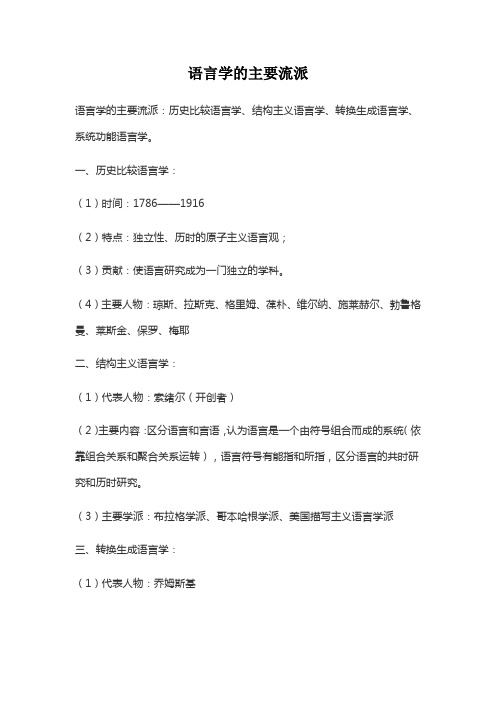
语言学的主要流派
语言学的主要流派:历史比较语言学、结构主义语言学、转换生成语言学、系统功能语言学。
一、历史比较语言学:
(1)时间:1786——1916
(2)特点:独立性、历时的原子主义语言观;
(3)贡献:使语言研究成为一门独立的学科。
(4)主要人物:琼斯、拉斯克、格里姆、葆朴、维尔纳、施莱赫尔、勃鲁格曼、莱斯金、保罗、梅耶
二、结构主义语言学:
(1)代表人物:索绪尔(开创者)
(2)主要内容:区分语言和言语,认为语言是一个由符号组合而成的系统(依靠组合关系和聚合关系运转),语言符号有能指和所指,区分语言的共时研究和历时研究。
(3)主要学派:布拉格学派、哥本哈根学派、美国描写主义语言学派三、转换生成语言学:
(1)代表人物:乔姆斯基
(2)大致内容:采用现代数理逻辑的形式化方法,根据有限规则演绎无限的句子。
四、系统功能语言学
(1)代表人物:韩礼德
(2)主要内容:重视语言在社会学上的特征,研究如何根据特定交际目的选择特定的语句,集中力量发现描写语言在社会中的规律;从认知的角度解释语言现象;注重个别语言以及个别变体的描写,发现语句在社会中的规律。
西方三大语言学流派。

西方三大语言学流派。
在语言学历史上,有三个主要的语言学流派:历史比较语言学、结构主义语言学和转换生成语言学。
19世纪,历史比较语言学(也称比较语言学)运用“历史比较法”,对不同语言进行比较分析,揭示语言间的亲属关系以及它们的历史发展。
其中,___是历史比较语言学的先驱人物。
1786年,他在加尔各答“___”宣读了一篇论文《三周年演说》,指出梵语和欧洲希腊语、拉丁语、凯尔特语和日耳曼语的结构具有惊人的相似之处,因而他断言,这些语言必有一个共同的来源。
此后的100年中,学者们忙于各种语言的历史比较,先是在印欧语系的各种语言之间进行比较,后来则是构拟它们的母语——原始印欧语。
历史比较语言学的奠基人包括德国语言学家___、丹麦语言学家___和德国语言学家___。
他们分别在1816年、1818年和1819年发表了重要著作,揭示了这些语言的对应规则和语音上的形式对应关系,并提出了语音演变规律,对于确认印欧语亲属关系、了解民族历史具有十分重要的意义。
总的来说,历史比较语言学是揭示语言间亲属关系和历史发展的重要方法,为后来的语言学研究奠定了基础。
根据格里木的解释,日耳曼语族中自成一体的三组音与更早的原始印欧语的发音进行比较,发现它们都曾发生过音变。
具体情况如下:原始印欧语的浊塞音b、d、g变成了日耳曼母语中的清塞音p、t、k。
例如,拉丁语中的duo(二)、genu (膝)在古冰岛语中变成了tveir、___。
原始印欧语的清塞音p、t、k变成了日耳曼母语中的清擦音f、th、h。
例如,拉丁语中的pater(父)、tu(你)在古冰岛语中变成了faðir、þu。
原始印欧语的送气浊塞音bh、dh、gh变成了日耳曼母语中的浊塞音b、d、g。
例如,梵语的___(兄弟)在英语中为___。
___是历史比较语言学的代表性人物之一,他提出了语言的“谱系分类法”,开创了构拟重建的方法。
19世纪中叶,历史比较语言学已经相当成熟并取得了丰硕的成果。
- 1、下载文档前请自行甄别文档内容的完整性,平台不提供额外的编辑、内容补充、找答案等附加服务。
- 2、"仅部分预览"的文档,不可在线预览部分如存在完整性等问题,可反馈申请退款(可完整预览的文档不适用该条件!)。
- 3、如文档侵犯您的权益,请联系客服反馈,我们会尽快为您处理(人工客服工作时间:9:00-18:30)。
西方语言学流派漫谈Schools of Linguistics: some random thoughts北京外国语大学中国外语教育研究中心刘润清为何要讲流派问题?➢我主张,进入一个研究领域时,第一要宏观,第二要对思想(ideas) 感兴趣。
➢宏观:做研究,别一下扎到一个小领域、小题目里去,那样会见木不见林。
了解宏观背景,让你不失迷方向。
➢对思想、哲学理念感兴趣,比只对纯技术性的东西感兴趣,更有意义。
技术是手段,提高认识是追求。
1. 区分流派与分支1.1 流派多指思潮, 有代表人物, 代表著作, 主要观点, 研究方法, 盛行时代,有其影响, 往往有历史视角。
(它未必对领域中的诸多问题都有论述。
)Schools refer to trends of thought, with their representative figures, works, unique ideas, methods and influence on later development; a diachronic perspective.1.2 分支多指领域, 研究范围, 也有经典著作, 有影响的人物, 多用共时观点。
可能多个流派都对它有过贡献。
(Branches refer to areas of study, with their classics, and influential figures; often a synchronic perspective.)1.3 历史视角和共时视角一起可以画出一个十字, 像一个坐标.The diachronic and synchronic perspectives will form a cross, which like a coordinate.Distinction between Schools and Branches1.2 语言学的分支: Branches:➢从内部分:语音学, 音系(位)学, 词汇学, 形态学, 句法学, 语义学, 语用学(?) Distinction from within: phonetics, phonology, lexicology, morphology, syntax, semantic, pragmatics (?)➢从外部分: 心理语言学, 社会语言学, 计算语言学, 神经语言学, 文化语言学, 人类语言学,语料库语言学等。
➢Distinction from without: psycholinguistics, sociolinguistics, computation linguistics, neurolinguistics, anthropological linguistics, cultural linguistics, corpus linguistics, etc.➢大分类: 理论语言学, 应用语言学Theoretical linguistics and applied linguistics.1.3 语言学流派:传统语法(600BC—18世纪)traditional grammar;历史语言学(19世纪100年) historical linguistics;现代语言学开端(索緖尔, 20世纪初) the beginning of modern linguistics;欧洲功能主义(20世纪20-50)European functionalism伦敦学派(1940—50)The London School;系统功能语法(1960—现在) Halliday’s Systemic-functional grammar美国结构主义语言学(1930—50) American structuralism美国转换生成语法(1957—现) Chomsky’s Generative Grammar认知语言学(today)Cognitive linguistics2. 宏观区分流派A More Macro Distinction2.1 形式派注重分析语言的形式, 结构, 成分和成分的分布, 对语言进行形式描写和描写的形式化, 考虑语言的心理性.The formal school: emphasize the formal, structural aspects of L, and distribution of elements; formalize the description of L; a psychological perspective.2.2 功能派注重分析语言的功能, 分析不同层次上的成分的语义功能, 认为功能决定形式, 考虑语言的社会性. The functional school: emphasize the functional nature of L; analyze the semantic function of elements on all levels; function determines form; a sociolinguistic perspective.2.3 两派的区别1/形式主义者认为语言是心理现象;功能主义者说语言是社会现象.The formal camp say language is a psychological fact; the functional camp say language is a social fact.2. 形式主义者说语言普遍现象是人类生理遗传;功能主义者说是来自社会对语言的普遍运用. The formal camp say linguistic universals are men’s biological inheritance; the functional camp say language similarities come from the common use of language.3.形式主义者说儿童习得语言是人类的内在能力;功能主义者说这是儿童交际的需要和能力的发展. The formal camp say that children are born with the ability to acquire language; the functional camp say that language learning comes from children’s needs and development.4.形式主义者把语言当成独立系统研究;功能主义者把语言放在社会功能中研究。
The formalists regard language as an independent system; the formalists study language in the social context by referring to its social function.2.4 韩礼德: 20世纪下半叶的基本对立阵营不是结构主义与生成语法。
最根本的两大阵营是:以组合关系为取向的形式派(形式语法,源于逻辑和哲学),和以聚合关系为取向的功能派(功能语法,源于修辞和人种学)。
形式派把语言看成一系列的结构,这些结构之间可以找出固定的关系(所以才有转换一说);他们强调语言的普遍性,把语法(他们称之为句法)看成是语言的基础(所以语法是任意的),因此语法围绕着句子而展开。
Halliday: The basic opposition is not that between ‘structural’and ‘generative’grammars . The more fundamental opposition is between those that are primarily symtagmatic in orientation (by and large the formal grammars, with their roots in logic and philosophy)and those that are primarily paradigmatic (by and large the functional ones, with their roots in rhetoric and ethnography). The former interpret a language a list of structures, among which, regular relationships may be established (hence the introduction of transformation); they tend to emphasize universal features of language, to take grammar (which they call syntax) as the foundation of language (hence the grammar is arbitrary), and so to be organized around the sentence功能派把语言看成是一个关系网,其基本关系借助于结构加以实现;他们强调语言之间的不同点,把语义看做语言的基础(所以语法是自然的),因此语法是围绕着文本或语篇而展开的。
两个阵营之间有许多交叉,也有互相借鉴,但从思潮上讲二者是很不同的,两大阵营开展对话也很困难。
The functionalists interpret language as a network of relations, with structures coming in as the realization of these relationships; they tend to emphasize variables among languages, to take semantics as the foundation (hence the grammar is natural), and so to be organized around the text, or discourse.There are many cross-currents, with insights borrowed from one to the other; but they are ideologically fairly difficult and it is often difficulty to maintain a dialogue.韩礼德还说:功能语法属于应用研究,形式语法属于纯理论研究;功能语法更近于修辞,形式语法更近于逻辑;功能语法研究实际语言能力,形式语法研究理想的语言能力;功能语法研究文本/语篇,形式语法研究句子。
